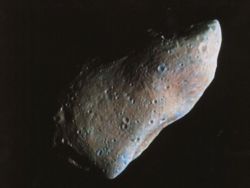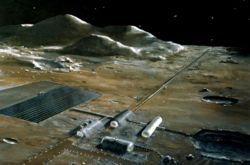Resources in space
| << Page in early stages >> |
|---|
Space is deficient in simple resources like air and this might put one off the idea of colonising it unless it had other charms to make up for this defect...
Living space
If we mined the moon and asteroid to build space colonies, we could ultimately have living space in these colonies 1000 times greater than the land area of Earth – and all this living space would be in pleasant temperature and conditions with abundant clean energy. As explained on the discussion of population, Gerard O'Neill has estimated that a series of space habitats around the Earth and Sun could sustain 80 trillion people comfortably.
Energy
Energy is one resource in abundance in space. See the discussion of space-based solar power for more. In space the sun is always shining and there is no atmosphere to attenuate its glare. Solar power is the obvious way to go, at least in the inner solar system.
Minerals
The asteroid belt, the Moon and other nearby parts of the solar system hold abundant mineral deposits.
Asteroid mining
The book Mining the Sky  by Prof. John S. Lewis
by Prof. John S. Lewis  explains in some detail what mineral resources are available in our solar system, even in near-Earth orbits. For example, the near-Earth asteroid (6178) 1986 DA
explains in some detail what mineral resources are available in our solar system, even in near-Earth orbits. For example, the near-Earth asteroid (6178) 1986 DA  contains 10,000 tons of gold, 100,000 tons of platinum, 10 billion tons of iron and a billion tons of nickel.
contains 10,000 tons of gold, 100,000 tons of platinum, 10 billion tons of iron and a billion tons of nickel.
Asteroid mining may seem futuristic, but in fact is already an area of commercial venture. Planetary Resources  is a company that unveiled in April 2012 a plan to mine asteroids for rocket fuel and rare metals like platinum.
is a company that unveiled in April 2012 a plan to mine asteroids for rocket fuel and rare metals like platinum.
First the asteroids must be prospected by remote scanning from space-based telescopes. There are an estimated half-million to one million near-Earth objects, with more being discovered every day. Telescopes and scanners can identify which of these are the best targets for mining, by virtue of being easily accessible and composed of valuable substances. Then they could either by mined by robots, or nudged into Earth orbit by explosives.
Some advances in robotic technology are needed and cheaper space launch is certainly needed. Notwithstanding these technical challenges, the asteroid mining mission has been dealt a few favourable cards. About 15% of near-Earth asteroids are shorter hops away from Earth than the Moon. Asteroids have no atmosphere or gravitational pull to hamper easy landing and takeoff. In this sense, a robotic mission to a well-chosen asteroid is easier than to the Moon.
Mining the moon
Building a mining colony on the Moon is possible with today's technology. (Indeed, it was one of the policies on which Newt Gingrinch campaigned for Republican presidential nomination in 2012.) From this colony, we could mine enormous quantities of iron, aluminium and titanium and launch them into space using a mass driver. Launching from the Moon is much easier than from Earth, because there is much less gravity and no air resistance. Having construction metals cheaply and abundantly available in space is essential for many of our most ambitious plans in space: aluminium mirrors could be used to terraform Mars, and other off-Earth habitats such as O'Neill cylinders could be made from lunar minerals and provide living space for trillions of people.
See also
- Fundamental resources (on Earth)


